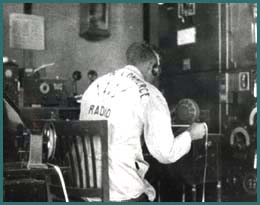Photo Album - The Foundation
- Air Mail Pioneers
- MacCracken and the Aeronautics Branch
- Safety Certification Begins
- Building the Airways
- Airway Communications
- Aeronautics Branch Aircraft
- Vidal and the Bureau of Air Commerce
Airway Communications
In 1927, the Aeronautics Branch took over 17 aeronautical radio stations from the Post Office Department. The Branch soon began to establish more of these facilities, which served as gathering points for data on weather and flights to be used in briefing pilots. The stations transmitted this information along the airways by radio and later by teletype via ground lines.
| At right is the St. Louis Airway Radio Station during the late 1920s or early '30s. Barely visible in the photo is the wire strung between the tops of its twin antenna towers. During this era, some stations were making hourly weather broadcasts. When needed for safety, they also accepted messages from the airlines and transmitted them to pilots aloft. |

|

|
The photo at left shows the interior of the Airway Radio Station at Portland, Oregon, about 1929. Carl Anderson examines a strip of the code in which the station operators made most of their transmissions during this period. |
| The view at right dates from about 1940, when the evolving facilities were known as Interstate Airway Communication Stations (INSACs). Women often staffed the stations, particularly during the World War II era. |

|
The names, procedures, and equipment of the facilities continued to change with the advance of technology. Today's Automated Flight Service Stations have inherited their mission of keeping pilots abreast of safety-related information.
